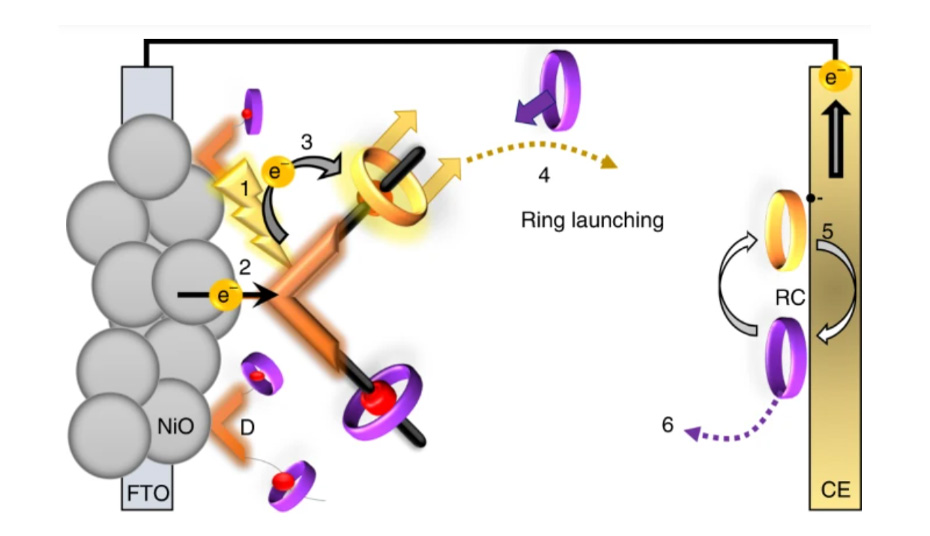
on UvA website: hims.uva.nl
In a paper just published in Nature Chemistry, Dr. Tessel Bouwens and co-workers present a strategy for directional charge propagation in photoelectrochemical devices. They show how pseudorotaxane motifs can be used as molecular machinery to reduce charge recombination in p-type dye-sensitized solar cells, thus enhancing their efficiency. The work was carried out in a collaboration between the groups of Prof. Joost Reek (University of Amsterdam) and Dr Annemarie Huijser (University of Twente).
The paper presents a sophisticated molecular design based on a pseudorotaxane with a neutral naphthalene diimide based ring. Solar cells with this type of molecular machine display a five times higher efficiency when compared to solar cells lacking the pseudorotaxane. Electron recombination is prevented because the moving rotaxane-ring establishes charge separation through a process of ‘ring launching’: electrons generated in the dye are transferred to the rotaxane ring that subsequently experiences a fast repulsion from the dye. Femtosecond TA studies carried out at the University of Twente provide direct evidence for this ring-launching mechanism. Light amperometry and electrochemical impedance spectroscopy under varying light intensities established that both preorganization and ring launching contributes to lowering recombination and a threefold extension to hole lifetimes, leading to a higher VOC and 16 times increase in PCE in p-DSSC.
Abstract of the paper
Molecular photoelectrochemical devices are hampered by electron–hole recombination after photoinduced electron transfer, causing losses in power conversion efficiency. Inspired by natural photosynthesis, we demonstrate the use of supramolecular machinery as a strategy to inhibit recombination through an organization of molecular components that enables unbinding of the final electron acceptor upon reduction. We show that preorganization of a macrocyclic electron acceptor to a dye yields a pseudorotaxane that undergoes a fast (completed within ~50 ps) ‘ring-launching’ event upon electron transfer from the dye to the macrocycle, releasing the anionic macrocycle and thus reducing charge recombination. Implementing this system into p-type dye-sensitized solar cells yielded a 16-fold and 5-fold increase in power conversion efficiency compared to devices based on the two control dyes that are unable to facilitate pseudorotaxane formation. The active repulsion of the anionic macrocycle with concomitant reformation of a neutral pseudorotaxane complex circumvents recombination at both the semiconductor–electrolyte and semiconductor–dye interfaces, enabling a threefold enhancement in hole lifetime.
Publication details
T. Bouwens, T. M. A. Bakker, K. Zhu, J. Hasenack, M. Dieperink, A. M. Brouwer, A. Huijser, S. Mathew, J. N. H. Reek: A Bioinspired Strategy for Directional Charge Propagation in Photoelectrochemical Devices Using Supramolecular Machinery Nat. Chem. (2022). DOI: 10.1038/s41557-022-01068-y



